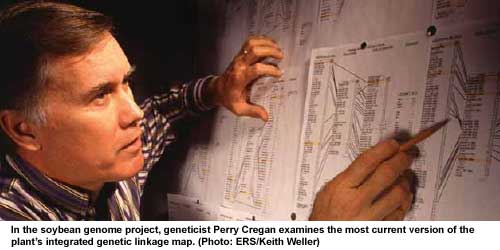Soybean genome unravelling speeds up quality breeding

The soybean, one of the most important global sources of protein and oil, is now the first major crop legume species with a complete published draft genome sequence. This sequence, which essentially provides a parts list of the soybean genome, will help scientists use the plant’s genes to improve its characteristics.
By Dick Ziggers
Scientists will use the new sequence to identify which genes are responsible for particular plant characteristics, and then target specific genes to produce desired characteristics. These may include increases in the plant’s oil content to promote the use of soybean oil as a biofuel; bigger crops; improved resistance to pests and diseases; improvements in the digestibility of soybeans by animals and humans; and, reductions in contaminants present in the manure of soybean-fed pig and poultry that may pollute farm runoff.
The research team plans to identify which soybean genes warrant targeting by comparing the genomes of different varieties of soybean plants to one another. They also aim to re-sequence 20,000 soybean lines that are currently stored in the National Plant Germplasm System to identify desired varieties of genes that are not currently captured by domesticated soybean lines.
Genes left behind
“When soybeans were domesticated, they were selected for seed size and other traits, but there were a lot of potentially valuable genes left behind,” says Scott Jackson of Purdue University. “There may be valuable genes associated with protein content or disease resistance in the stored lines that are currently not in the cultivated lines.”
Having the new soybean sequence as a reference will significantly speed up and reduce the costs of re-sequencing the 20,000 stored soybean lines. The close co-ordination of support for the project was facilitated by the National Plant Genome Initiative, which is managed by the Interagency Working Group on Plant Genomes. Funding for the mapping/sequencing study was also provided by the United Soybean Board.US Department of Agriculture (USDA) scientists are part of a team that has sequenced the majority of the soybean genome.
“Soybean and other legumes play a critical role in global food security and human health and are used in a wide range of products, from tofu, soy flour, meat substitutes and soy milk to soy oil-based printing ink and biodiesel,” says Molly Jahn, USDA Deputy Under Secretary for Research, Education and Economics. “This new information about soybean’s genetic make-up could lead to plants that produce more beans that contain more protein and oil, better adapt to adverse environmental conditions, or are more resistant to diseases.”
“Shotgun” approach
This sequencing of the soy genome is the culmination of more than 15 years of collaborative research. The team used a so-called “whole-genome shotgun (WGS)” approach to sequence 85% of the 1.1 billion nucleotide base pairs that spell out soy’s entire DNA code. The sequence also provides researchers with a critical reference to use in deciphering the genetics of some 20,000 other legume species.
The work of geneticists Randy Shoemaker, Perry Cregan, David Hyten, Steven Cannon and David Grant with the USDA’s Agricultural Research Service (ARS) involved the creation of genetic markers and the development of the soybean (Glycine max) genetic map that facilitated “anchoring” of the genome sequence to the 20 sets of soybean chromosomes. ARS is USDA’s principal intramural scientific research agency.The Department of Energy’s Joint Genome Institute, Purdue University (West Lafayette, Indiana), the University of Missouri (Columbia), and the University of Arizona (Tucson) also participated in the soybean sequencing project, which was supported by the United Soybean Board, the National Science Foundation, and USDA’s National Institute of Food and Agriculture (NIFA). Through federal funding, NIFA invests in science to solve critical issues impacting people’s daily lives and the nation’s future.
Speed up cultivar development
According to USDA’s Shoemaker, who is with the ARS Corn Insects and Crop Genetics Research Unit in Ames, Iowa, integrating the new sequence with existing physical and genetic maps of soy will move researchers closer to linking observable physical traits of soy to their associated genes and alleles – alternate versions of genes. Ultimately, this will speed up the development of new soybean cultivars offering higher seed yields, increased protein and oil contents, better adaptability and improved disease resistance, particularly to Asian soybean rust (ASR), which threatens America’s $27 billion soy crop.
“Overlaying the sequence onto available maps will expedite identification and orientation of genetic markers such as single nucleotide polymorphisms, which are often located near genes that control agronomically important traits,” says Shoemaker.
Using such markers, soy breeders can rapidly determine which offspring plants have inherited these traits without growing them to maturity, saving time, money and resources. “We’ve mapped the locales for about 90 important traits affecting soybean growth and development, seed yield, seed protein and oil, and disease resistance, to name but a few,” Shoemaker added. “With this high-quality sequence, we now have access to candidate genes that we’ve never had before, which will enable us to look at their patterns of expression, develop molecular markers to track them in breeding programmes, and work with them to determine their function, or modify them to improve their function.”
Key discoveries
Some key discoveries already gleaned from the whole-genome sequence include the first soybean gene conferring resistance to ASR, which can cause soy losses of 10-80%; a mutation that could make soybeans easier to digest by producing lower levels of a carbohydrate called stachyose; a mutation for higher levels of production of the enzyme phytase that could enable livestock to absorb more phosphorus from soybean feed so less is excreted as a potential water contaminant; and 52 genes that orchestrate development of soy plant root nodules, where symbiotic bacteria transform atmospheric nitrogen into a form soybeans and other crops can use for their growth and development. AAF
The soybean sequencing study appeared as the cover story of the January 14 edition of Nature, Genome sequence of the palaeopolyploid soybean.











